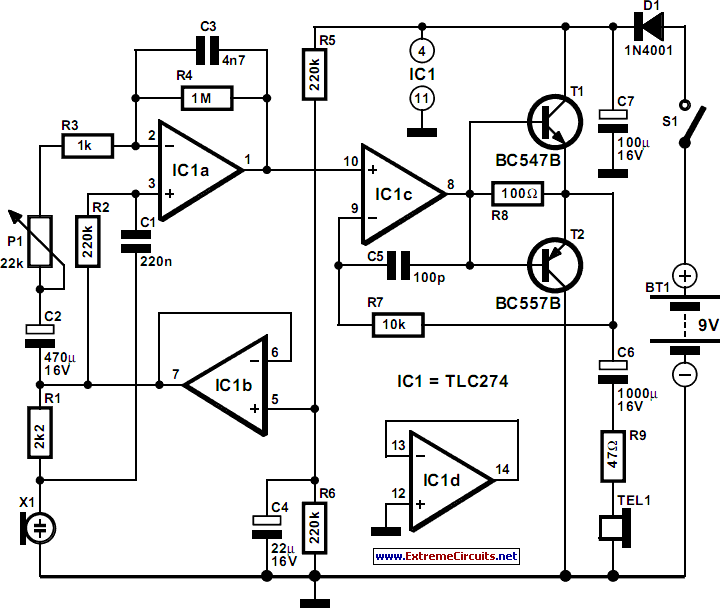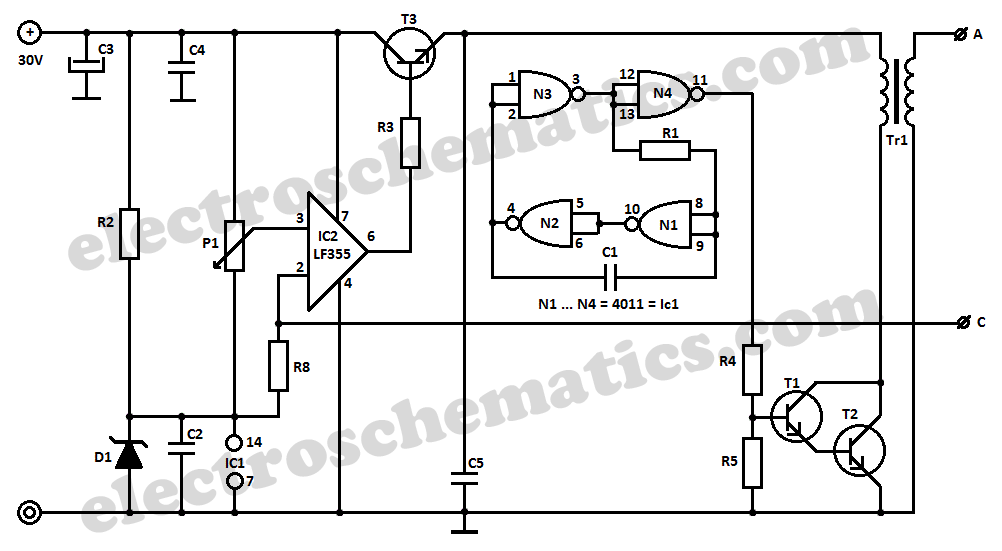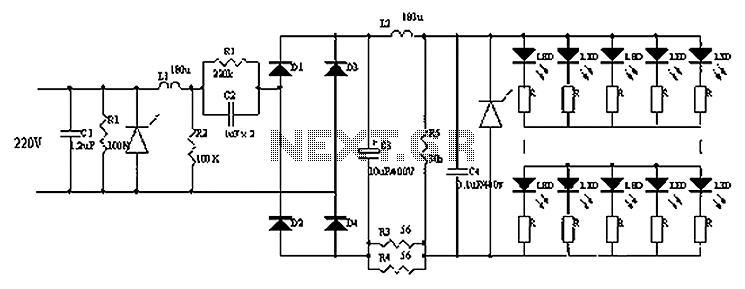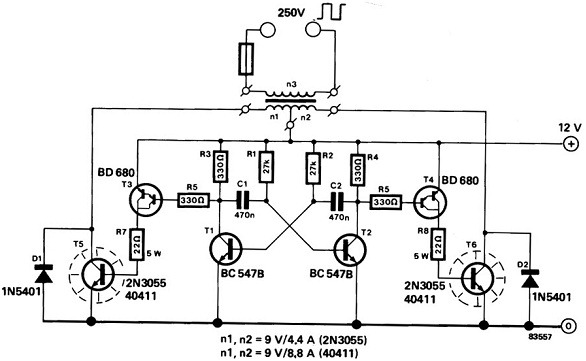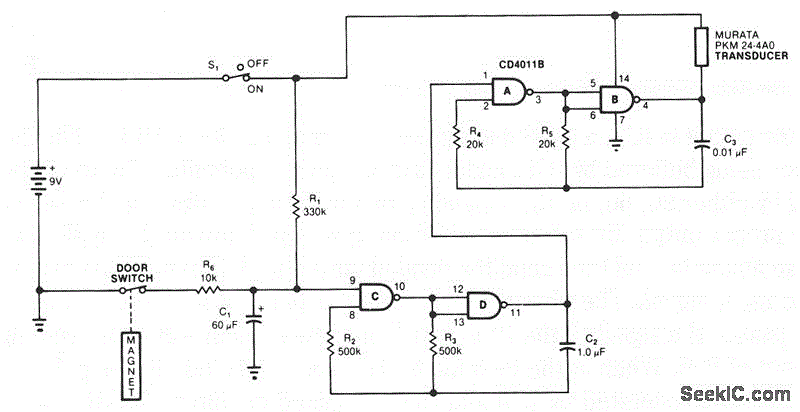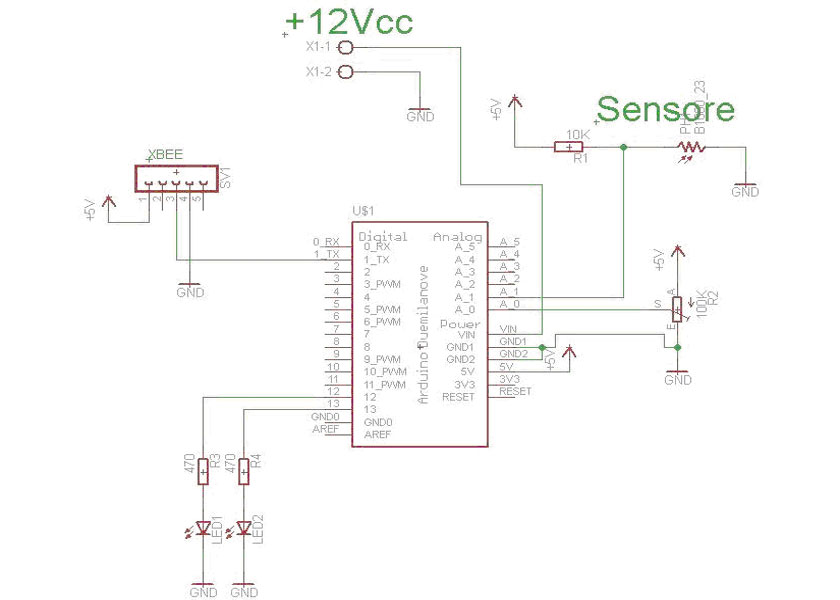
220V Mains Quality Monitor
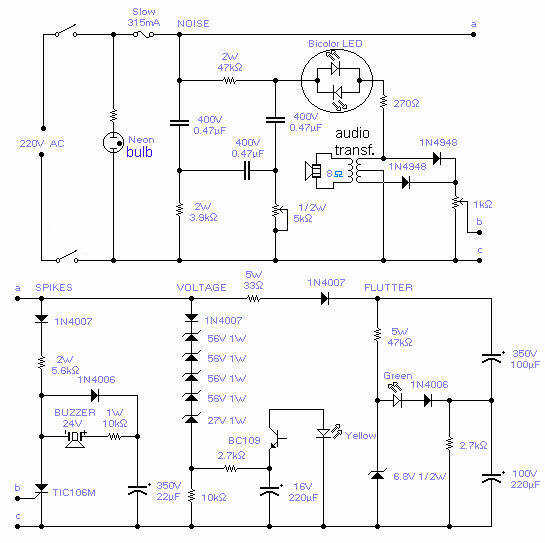
With this circuit you will be able to monitor the quality of the mains. There are 4 distinct sections, each supervising a parameter pertinent to the quality of the supply line. The noise section consists of a 50Hz filter and a speaker where you will hear the noise present on the line. The bicolor LED should be adjusted for the least light with the 5k pot and gives a visual indication of noise or asymmetry in the wave. The second section will detect any spike which is overimposed on the mains voltage: adjust the pot so that it will not trip if you just switch on the light, sensitivity is high enough to detect a switching operation from a close neighbor. More: The buzzer will beep for about 1sec anytime there is a spike. The actual voltage is detected with section 3: the yellow led will blink at a rate of 6 Hz but will visibly double to 12 Hz for a 10% increase or will come to a halt for a 10% decrease of the voltage. The last section will show the flutter or slow variations of the mains voltage. The circuit will work for a 220V mains: for 230V operation, change the 27V zener to 39V and for 60Hz operation change the 3.9k resistor to 3.3k and the 47k resistor to 39k. Operation at 110V will call for a major redesign of the component values and has not been attempted.
The circuit is designed to monitor various parameters of mains quality, providing both auditory and visual feedback. It is divided into four primary sections, each responsible for assessing a specific aspect of the mains supply.
The first section focuses on noise detection and incorporates a 50Hz low-pass filter along with a speaker. This arrangement allows the user to hear any noise present in the mains supply. A bicolor LED, adjustable via a 5k potentiometer, provides a visual representation of noise levels or waveform asymmetry. The adjustment of the potentiometer is crucial for calibrating the LED to indicate minimal light in normal operating conditions.
The second section is dedicated to spike detection. It is designed to identify voltage spikes that may occur on the mains line. A potentiometer is included to set the sensitivity of the detection circuit, ensuring that it does not trigger false alarms during routine operations, such as switching on lights. However, it remains sensitive enough to detect nearby switching operations.
In the third section, the circuit monitors the actual mains voltage. A yellow LED is employed to indicate voltage levels, blinking at a frequency of 6 Hz under normal conditions. If a 10% increase in voltage is detected, the blinking rate increases to 12 Hz, while a 10% decrease in voltage causes the LED to stop blinking altogether. This provides an immediate visual reference for voltage stability.
The final section of the circuit is responsible for monitoring slow variations or 'flutter' in the mains voltage. This aspect is critical for assessing the overall stability of the supply.
For operation with a 220V mains supply, the circuit is appropriately configured. However, for a 230V supply, modifications are necessary: the 27V zener diode should be replaced with a 39V component, and for 60Hz operation, the resistor values must be adjusted from 3.9k to 3.3k and from 47k to 39k. It is noted that adapting the circuit for 110V operation would require significant redesign and has not been attempted.With this circuit you will be able to monitor the quality of the mains. There are 4 distinct sections, each supervising a parameter pertinent to the quality of the supply line. The noise section consists of a 50Hz filter and a speaker where you will hear the noise present on the line.
The bicolor LED should be adjusted for the least light with the 5k pot and gives a visual indication of noise or asymmetry in the wave. The second section will detect any spike which is overimposed on the mains voltage: adjust the pot so that it will not trip if you just switch on the light, sensitivity is high enough to detect a switching operation from a close neighbor.
The buzzer will beep for about 1sec anytime there is a spike. The actual voltage is detected with section 3: the yellow led will blink at a rate of 6 Hz but will visibly double to 12 Hz for a 10% increase or will come to a halt for a 10% decrease of the voltage. The last section will show the flutter or slow variations of the mains voltage. The circuit will work for a 220V mains: for 230V operation, change the 27V zener to 39V and for 60Hz operation change the 3.9k resistor to 3.3k and the 47k resistor to 39k.
Operation at 110V will call for a major redesign of the component values and has not been attempted. 🔗 External reference
The circuit is designed to monitor various parameters of mains quality, providing both auditory and visual feedback. It is divided into four primary sections, each responsible for assessing a specific aspect of the mains supply.
The first section focuses on noise detection and incorporates a 50Hz low-pass filter along with a speaker. This arrangement allows the user to hear any noise present in the mains supply. A bicolor LED, adjustable via a 5k potentiometer, provides a visual representation of noise levels or waveform asymmetry. The adjustment of the potentiometer is crucial for calibrating the LED to indicate minimal light in normal operating conditions.
The second section is dedicated to spike detection. It is designed to identify voltage spikes that may occur on the mains line. A potentiometer is included to set the sensitivity of the detection circuit, ensuring that it does not trigger false alarms during routine operations, such as switching on lights. However, it remains sensitive enough to detect nearby switching operations.
In the third section, the circuit monitors the actual mains voltage. A yellow LED is employed to indicate voltage levels, blinking at a frequency of 6 Hz under normal conditions. If a 10% increase in voltage is detected, the blinking rate increases to 12 Hz, while a 10% decrease in voltage causes the LED to stop blinking altogether. This provides an immediate visual reference for voltage stability.
The final section of the circuit is responsible for monitoring slow variations or 'flutter' in the mains voltage. This aspect is critical for assessing the overall stability of the supply.
For operation with a 220V mains supply, the circuit is appropriately configured. However, for a 230V supply, modifications are necessary: the 27V zener diode should be replaced with a 39V component, and for 60Hz operation, the resistor values must be adjusted from 3.9k to 3.3k and from 47k to 39k. It is noted that adapting the circuit for 110V operation would require significant redesign and has not been attempted.With this circuit you will be able to monitor the quality of the mains. There are 4 distinct sections, each supervising a parameter pertinent to the quality of the supply line. The noise section consists of a 50Hz filter and a speaker where you will hear the noise present on the line.
The bicolor LED should be adjusted for the least light with the 5k pot and gives a visual indication of noise or asymmetry in the wave. The second section will detect any spike which is overimposed on the mains voltage: adjust the pot so that it will not trip if you just switch on the light, sensitivity is high enough to detect a switching operation from a close neighbor.
The buzzer will beep for about 1sec anytime there is a spike. The actual voltage is detected with section 3: the yellow led will blink at a rate of 6 Hz but will visibly double to 12 Hz for a 10% increase or will come to a halt for a 10% decrease of the voltage. The last section will show the flutter or slow variations of the mains voltage. The circuit will work for a 220V mains: for 230V operation, change the 27V zener to 39V and for 60Hz operation change the 3.9k resistor to 3.3k and the 47k resistor to 39k.
Operation at 110V will call for a major redesign of the component values and has not been attempted. 🔗 External reference
Warning: include(partials/cookie-banner.php): Failed to open stream: Permission denied in /var/www/html/nextgr/view-circuit.php on line 713
Warning: include(): Failed opening 'partials/cookie-banner.php' for inclusion (include_path='.:/usr/share/php') in /var/www/html/nextgr/view-circuit.php on line 713
